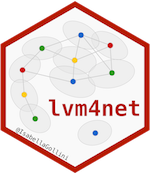lvm4net provides a range of tools for latent variable models for network data. Most of the models are implemented using a fast variational inference approach.
Latent space models for one-mode binary networks: the function lsm implements the latent space model (LSM) introduced by Hoff et al. (2002) using a variational inference and squared Euclidian distance; the function lsjm implements latent space joint model (LSJM) for multiplex networks introduced by Gollini and Murphy (2016). These models assume that each node of a network has a latent position in a latent space: the closer two nodes are in the latent space, the more likely they are connected.
Latent variable models for binary bipartite networks: the function lca implements the latent class analysis (LCA) to find groups in the sender nodes (with the condition of independence within the groups); the function lta implements the latent trait analysis (LTA) to model the dependence in the receiver nodes by using a continuous latent variable; the function mlta implements the mixture of latent trait analyzers (MLTA) introduced by Gollini and Murphy (2014) and Gollini (in press) to identify groups assuming the existence of a latent trait describing the dependence structure between receiver nodes within groups of sender nodes and therefore capturing the heterogeneity of sender nodes’ behaviour within groups. lta and mlta use variational inference.
References
Gollini, I. (in press) “A mixture model approach for clustering bipartite networks”, Challenges in Social Network Research Volume in the Lecture Notes in Social Networks (LNSN - Series of Springer). Preprint: arXiv:1905.02659.
Gollini, I., and Murphy, T. B. (2014), “Mixture of Latent Trait Analyzers for Model-Based Clustering of Categorical Data”, Statistics and Computing, 24(4), 569-588, arXiv:1301.2167.
Gollini, I., and Murphy, T. B. (2016), “Joint Modelling of Multiple Network Views”, Journal of Computational and Graphical Statistics, arXiv:1301.3759.
Hoff, P., Raftery, A., and Handcock, M. (2002), “Latent Space Approaches to Social Network Analysis”, Journal of the American Statistical Association, 97, 1090–1098.
Other learning material
- Material from the Sunbelt 2019 workshop on on Exploring networks using latent variable models in R with
lvm4netis available here
